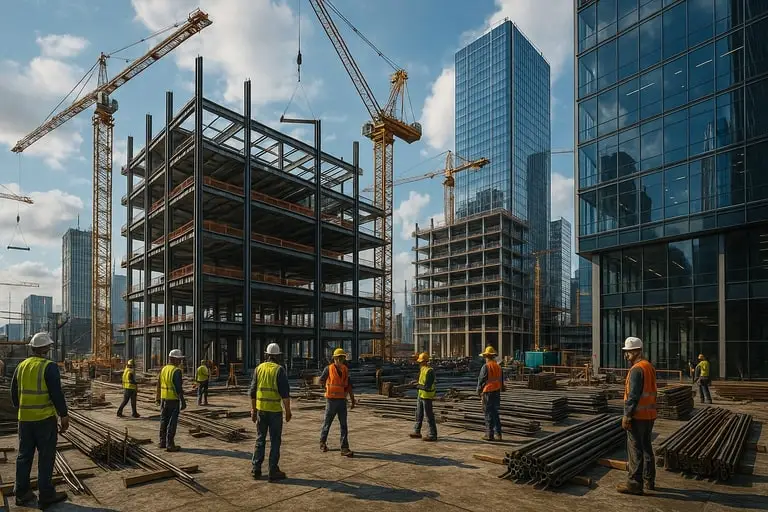Project management in building has emerged as the backbone of modern construction practices, ensuring that complex projects are delivered within budget, on time, and to the highest quality standards. At its core, it involves coordinating people, resources, and processes while anticipating risks and aligning with broader development goals. The ability to synchronize diverse teams—architects, engineers, contractors, and stakeholders—turns fragmented efforts into cohesive outcomes. As cities expand and demand for infrastructure intensifies, project management in building becomes not just a discipline but a critical driver of progress.
In construction, where uncertainty is inherent, project management ensures predictability. Without structured oversight, costs escalate, schedules slip, and quality suffers. When applied effectively, project management creates a framework where each task is interdependent, forming a chain that strengthens rather than falters under pressure. This methodology transforms construction from a reactive endeavor into a proactive process where challenges are mitigated before they spiral. Strategic foresight and disciplined execution create stability in projects of all scales.
The integration of project management in building with construction strategy fosters resilience in industries that operate under tight margins. Effective coordination empowers companies to manage scarce resources, reduce waste, and align with sustainability goals. By embedding resource planning into every decision, project managers bridge the gap between design and execution. This integration goes beyond timelines and budgets—it anchors projects in principles of long-term functionality, environmental responsibility, and urban development harmony.
Modern urban development adds another dimension to building projects, where project management plays a decisive role in shaping the built environment. Cities require more than structures; they need infrastructure that supports mobility, inclusivity, and ecological balance. Project management in building ensures that every decision—from material selection to land-use alignment—contributes to a coherent urban fabric. By uniting vision with execution, project managers ensure that individual projects do not stand in isolation but form part of an interconnected whole.
Communication is the lifeline of successful building projects, and project managers act as interpreters between diverse parties. Miscommunication between stakeholders often causes disputes, delays, and financial losses. By establishing clear channels and managing expectations, project managers provide transparency that builds trust. This trust allows teams to adapt to evolving conditions without fear of misalignment, transforming uncertainty into collaboration. In such contexts, effective project management in construction safeguards both investor confidence and community satisfaction.
Risk management, another pillar of building project management, requires anticipating challenges across financial, environmental, and operational domains. Whether dealing with supply chain disruptions or regulatory hurdles, proactive identification allows for contingency planning that preserves progress. Project managers apply frameworks that quantify risks, allowing leaders to make informed decisions rather than reactive guesses. This foresight enables smooth execution and strengthens the resilience of construction strategies even under volatile conditions.
Technology further amplifies the reach of project management in building. Tools such as Building Information Modeling (BIM), cloud-based collaboration platforms, and AI-driven forecasting transform how projects are planned and monitored. These innovations reduce errors, provide real-time visibility, and improve accountability across supply chains. The marriage of traditional construction expertise with digital precision enables projects to meet contemporary demands without sacrificing quality. It demonstrates how project management evolves alongside advancements in technology.
Sustainability underscores contemporary construction, and project managers play a crucial role in embedding eco-conscious practices into building strategies. Decisions about energy efficiency, waste reduction, and responsible sourcing require consistent oversight. By aligning sustainability goals with execution, project managers ensure that environmental considerations are not treated as afterthoughts but as integral components of every phase. This emphasis strengthens both brand reputation and regulatory compliance, while contributing to a more resilient built environment.
Financial stewardship forms another cornerstone of project management in building. Allocating budgets, managing expenditures, and maximizing value require more than accounting skills; they demand foresight and adaptability. Skilled project managers align financial strategies with long-term outcomes, ensuring that immediate savings do not compromise future performance. By maintaining balance, they protect profitability while delivering projects that meet evolving client and societal expectations.
Project management also enhances workforce productivity. Construction sites often involve dozens of subcontractors and multiple disciplines working simultaneously. Without structured oversight, chaos prevails. Project managers impose order through schedules, task sequencing, and accountability frameworks that reduce inefficiencies. This structured workflow not only accelerates progress but also promotes safety—a non-negotiable in high-risk building environments. In this way, project management strengthens both efficiency and well-being.
Ultimately, project management in building is not simply about completing structures—it is about shaping outcomes that endure. It blends vision with execution, ensuring that buildings are not only functional today but resilient tomorrow. By integrating construction strategy, sustainability, and human collaboration, project management creates a framework that elevates projects from temporary achievements to lasting contributions. Its role as a discipline of foresight, precision, and coordination confirms its place at the center of modern construction.
Project Management in Building Project Oversight
Project management in building project oversight emphasizes detailed coordination that ensures outcomes align with strategic intent. Oversight means more than monitoring; it encompasses guiding a project’s trajectory from inception to delivery with unwavering consistency. By integrating planning, resource allocation, and stakeholder alignment, oversight transforms uncertainty into confidence. This balance empowers project managers to drive progress without compromising adaptability, maintaining resilience across all phases.
Strong oversight ensures that construction processes remain streamlined. From ground preparation to finishing work, project management aligns timelines so that dependencies are respected and no phase becomes a bottleneck. This sequential integrity ensures that progress continues without interruptions that inflate costs and undermine morale. A clear vision, combined with disciplined execution, secures a project’s ability to advance smoothly even under challenging circumstances.
Financial responsibility defines oversight as much as technical expertise. By overseeing budgets and preventing scope creep, project managers preserve resources while maintaining value. Oversight transforms raw financial data into actionable insights, guiding decisions about procurement, labor allocation, and contingency reserves. This structured approach to financial stewardship ensures that building project management achieves more than cost control—it guarantees that investment translates into sustainable outcomes.
Communication flows are central to oversight. Construction sites involve a multitude of contractors, designers, and suppliers, each with distinct goals. Project managers act as conduits, ensuring that every voice is heard while aligning them toward common objectives. This careful mediation avoids disputes and accelerates decisions. When communication is managed effectively, collaboration flourishes, driving projects to completion with fewer conflicts and stronger partnerships.
Risk oversight requires vigilance across environmental, social, and technical domains. Construction projects are vulnerable to unpredictable events, from weather disruptions to regulatory changes. Through structured risk frameworks, project managers anticipate threats and embed countermeasures into the project plan. This proactive stance transforms oversight into a protective shield that allows projects to advance even when confronted with adversity.
Urban development pressures intensify the importance of oversight in building projects. Cities grow rapidly, demanding infrastructure that balances mobility, sustainability, and inclusivity. Oversight ensures that projects integrate seamlessly with urban strategies rather than creating isolated solutions. By guiding projects to contribute to broader societal goals, project managers become stewards of responsible urban growth, ensuring construction aligns with long-term community needs.
Technology strengthens oversight through advanced tools that provide real-time visibility. Cloud systems, predictive analytics, and digital twins give managers the ability to foresee bottlenecks and respond dynamically. Oversight extends beyond physical presence on-site to include virtual monitoring that magnifies efficiency. By leveraging technology, oversight becomes a force that ensures precision and transparency at unprecedented levels.
Sustainability oversight ensures that ecological goals are embedded throughout building projects. Project managers assess environmental impacts, select responsible materials, and enforce energy-efficient practices. Oversight guarantees that sustainability is not treated as an optional feature but as a defining parameter. This integration creates buildings that endure as responsible assets, contributing positively to both ecology and economy.
Human capital oversight is equally significant. Workers require safe environments, fair conditions, and structured workflows to thrive. Project managers oversee not only tasks but also well-being, embedding safety protocols and productivity systems. This balance cultivates workplaces that foster both efficiency and dignity. When human considerations align with technical oversight, the result is projects that honor people as much as performance.
Oversight also secures stakeholder trust. Investors, regulators, and communities require assurance that projects are managed responsibly. By maintaining transparency and demonstrating accountability, project managers strengthen credibility. Oversight thus transcends internal processes—it becomes a signal of reliability that attracts future opportunities and partnerships. Through such trust, project management in building oversight ensures continuity of success.
Ultimately, oversight embodies the essence of project management in building. It unites planning, execution, and accountability into a cohesive discipline that safeguards outcomes. By combining strategy with adaptability, oversight allows projects to navigate complexity without losing direction. Its enduring value lies in its ability to transform ambition into tangible achievements that meet both immediate needs and long-term aspirations.
Project Management in Building for Effective Construction
Project management in building for effective construction addresses the dynamic challenges of turning designs into lasting structures. Effectiveness is achieved when strategies align with execution, ensuring resources are maximized and objectives met. Project managers orchestrate this process by blending foresight with operational discipline. The result is construction that not only meets but often surpasses performance expectations through precision and adaptability.
Effectiveness depends on aligning multiple disciplines within a coherent framework. Architects, engineers, and contractors often approach projects from different priorities. Project management ensures that these perspectives converge rather than conflict. By setting clear objectives and managing interdependencies, project managers establish workflows where collaboration enhances productivity rather than causing inefficiencies. This alignment is critical in large-scale projects where complexity multiplies exponentially.
Time management defines effectiveness in construction. Delays undermine credibility and inflate costs, threatening the viability of projects. Project managers enforce schedules with precision, sequencing tasks to prevent bottlenecks. By proactively identifying potential disruptions, they maintain momentum even under unpredictable conditions. Effectiveness, therefore, is measured not only in completed structures but in the discipline that ensures timely delivery.
Cost-effectiveness complements time management as a defining marker of success. Project managers oversee expenditures with a balance of caution and foresight. They prevent unnecessary spending while allocating resources strategically to areas of maximum impact. This equilibrium secures financial health while ensuring that quality remains uncompromised. Effective project management in construction demonstrates how financial discipline translates into long-term resilience.
Sustainability contributes significantly to effective construction practices. Resource efficiency, energy-conscious design, and responsible material sourcing are no longer optional but essential. Project managers ensure that these principles are embedded from planning to execution. By aligning construction strategies with ecological imperatives, effectiveness acquires a broader meaning—delivering projects that serve present needs without jeopardizing future generations.
Technology underpins effectiveness through advanced tools that enhance accuracy and collaboration. Digital platforms for scheduling, modeling, and communication reduce inefficiencies and eliminate blind spots. By leveraging innovations such as BIM and predictive analytics, project managers elevate construction to a level of precision that surpasses traditional methods. This technological integration exemplifies how modern effectiveness relies on both human expertise and digital intelligence.
Risk management anchors effectiveness in uncertain environments. Unforeseen challenges, from supply chain disruptions to regulatory shifts, can derail progress. Project managers mitigate risks through contingency planning and adaptive strategies. Their vigilance ensures that construction remains resilient, enabling effective outcomes even when external pressures intensify. By embedding flexibility into planning, they transform vulnerability into opportunity.
Workforce productivity is central to effective construction. Project managers cultivate environments that balance safety with efficiency. By enforcing clear procedures and fostering collaboration, they elevate morale while reducing errors. The result is a workforce that operates at peak potential, ensuring that effectiveness is not an abstract concept but a lived reality on construction sites.
Community integration further defines effectiveness in construction. Buildings are not isolated structures; they influence neighborhoods and cities. Project managers align construction outcomes with community expectations, ensuring accessibility, functionality, and harmony with surroundings. This alignment builds social acceptance, transforming projects into assets that communities embrace rather than resist. Effectiveness thus extends beyond technical success to social contribution.
Stakeholder trust cements the effectiveness of construction projects. Investors, regulators, and end-users evaluate not only final outcomes but also the processes that achieved them. Project management guarantees transparency and accountability, reinforcing confidence that goals will be achieved responsibly. This trust becomes a foundation for future projects, ensuring continuity of opportunity and growth.
Ultimately, project management in building for effective construction represents the convergence of strategy, precision, and accountability. It translates blueprints into realities that endure, combining technical mastery with societal vision. Effectiveness is achieved not by chance but by discipline, foresight, and human collaboration. In uniting these dimensions, project managers transform construction into a process that consistently delivers excellence.
In the evolving landscape of architecture and engineering, the concept of construction strategy has emerged as the guiding framework that determines whether projects succeed or collapse under pressure. More than a blueprint for physical structures, it is a philosophy of coordination, efficiency, and foresight that connects every phase of development.
From land acquisition and zoning approval to supply chain management and project delivery, a well-defined construction strategy provides clarity of vision while reducing risks that can drain both capital and confidence. When stakeholders understand the roadmap in advance, they can align expectations, allocate resources intelligently, and anticipate challenges before they become costly obstacles. This shift from reactive problem-solving to proactive planning distinguishes companies that thrive from those that stagnate in a competitive industry.
The importance of construction strategy becomes particularly clear in urban development, where timelines are compressed, budgets scrutinized, and environmental impacts unavoidable. A carefully structured approach addresses not only technical execution but also community integration and regulatory compliance. Rather than treating these as separate checklists, strategy interweaves them into a holistic system where one decision strengthens the next.
For instance, sustainable material choices feed into energy-efficient building systems, which in turn reduce long-term operational costs and align with green certification standards. By unifying short-term construction tasks with long-term sustainability goals, firms build more than structures: they build reputations that attract future investment. In this way, strategy operates as an engine of growth and differentiation, allowing businesses to move beyond transactional building into transformational development.
Equally vital is the role of construction strategy in mitigating risk. Every project is vulnerable to delays, supply chain disruptions, or sudden shifts in labor markets, but not every project collapses under these pressures. The difference lies in foresight. A solid plan does not eliminate uncertainty, but it builds resilience into the process.
Buffer times, flexible contracts, and scenario analysis allow managers to adapt without derailing progress. Insurance providers, investors, and regulators all gain greater confidence when they see that the plan anticipates challenges instead of ignoring them. This, in turn, reduces financing costs and accelerates approval timelines. The presence of a visible, well-articulated construction strategy therefore pays dividends before a single foundation is poured, creating competitive advantages that compound over time.
On the operational level, construction strategy drives efficiency by synchronizing trades, equipment, and materials in a precise sequence. Instead of chaotic overlaps that waste labor hours and strain budgets, teams follow a choreography designed to minimize downtime.
Digital tools such as Building Information Modeling (BIM) and AI-driven scheduling software now amplify this benefit, offering predictive analytics that forecast bottlenecks weeks before they occur. The ability to course-correct in real time reduces costly errors while maximizing productivity. In industries where margins are tight, even small percentage gains in efficiency translate into millions of dollars saved. Thus, strategic planning is not a luxury but a profit center, redefining how firms measure success.
A forward-thinking construction strategy also embraces sustainability as a non-negotiable pillar. Clients, governments, and communities are demanding greener outcomes, and projects that fail to deliver face reputational backlash and legal hurdles. Incorporating renewable energy systems, recycled materials, and circular economy principles into the design phase is far easier than retrofitting later.
More importantly, it positions developers as responsible leaders in a field undergoing rapid transformation. Firms that master the balance between innovation and responsibility will not only win tenders but also inspire trust among increasingly environmentally conscious stakeholders. Strategy, in this sense, becomes the compass that keeps ethical imperatives aligned with financial objectives.
Equity and community inclusion further underscore the strategic dimension of modern building. Construction is no longer judged solely by skyline aesthetics or structural longevity. The social footprint matters. A strong construction strategy ensures that projects consider affordable housing ratios, public transport access, and local job creation as integral outcomes.
These choices reinforce public goodwill, streamline political negotiations, and reduce the likelihood of community resistance. By embedding inclusivity into the earliest stages of planning, firms avoid the costly delays that arise when protests, lawsuits, or public opposition erupt. In a world where reputational risks spread instantly across digital platforms, alignment with community values is not optional—it is indispensable.
Another dimension where construction strategy asserts its value is in technology adoption. Digital twins, modular construction, 3D printing, and robotics are transforming how buildings rise from the ground. Yet without a roadmap, technology often adds complexity rather than reducing it.
A strategic approach determines which innovations align with project goals, budget limits, and workforce capabilities. It integrates new tools without creating fragmentation, ensuring that efficiency gains outweigh training costs or logistical hurdles. Firms that approach technology through the lens of strategy unlock innovation as a driver of competitive advantage rather than a source of confusion.
Leadership and human capital are also inseparable from construction strategy. Even the most advanced digital models and sustainable materials cannot substitute for skilled labor, motivated teams, and visionary managers. Strategy establishes pathways for training, communication, and conflict resolution. It defines accountability while fostering collaboration across diverse stakeholders—architects, engineers, contractors, regulators, and clients.
A culture of transparency and shared purpose grows when leaders articulate not just the “what” but the “why” behind decisions. The result is a workforce that executes tasks with precision because they understand the bigger picture. In industries notorious for fragmentation and miscommunication, this cultural cohesion is a decisive asset.
Finally, construction strategy must be understood as a living document, not a static binder gathering dust. The external environment—economic cycles, climate risks, demographic shifts—changes constantly, and projects that fail to adapt lose relevance or face obsolescence. Continuous monitoring, feedback loops, and post-occupancy evaluations transform strategy from a rigid manual into an evolving guide.
Lessons learned from one development feed into the next, creating institutional memory that compounds over decades. In this way, firms convert strategy into a long-term asset, capable of withstanding disruption and ensuring consistent excellence. Construction thus becomes not a series of isolated projects but a continuous practice of strategic growth.
In conclusion, the essence of construction strategy lies in integration: technical precision, financial foresight, environmental responsibility, and social inclusivity working together in harmony. When organizations elevate strategy from a checklist to a philosophy, they unlock the potential to shape cities, industries, and communities for generations. The structures that rise from this vision are more than concrete and steel; they are embodiments of trust, intelligence, and resilience. In a world of mounting complexity, strategy provides the anchor—and the wings—that allow modern construction to thrive.













